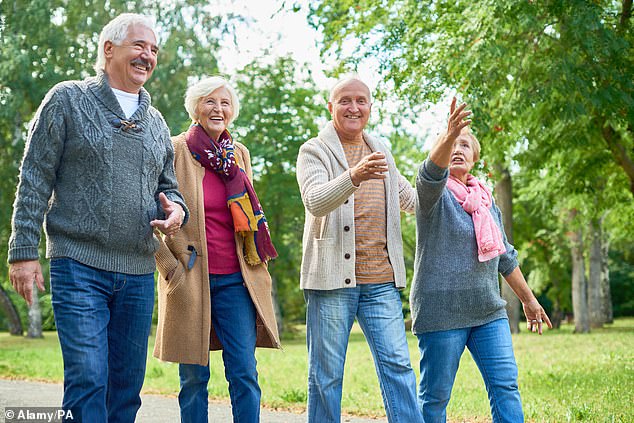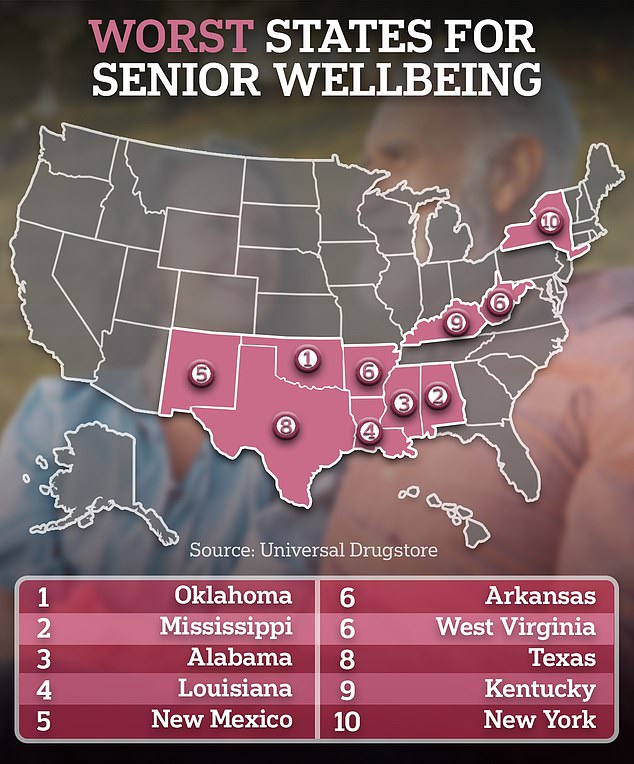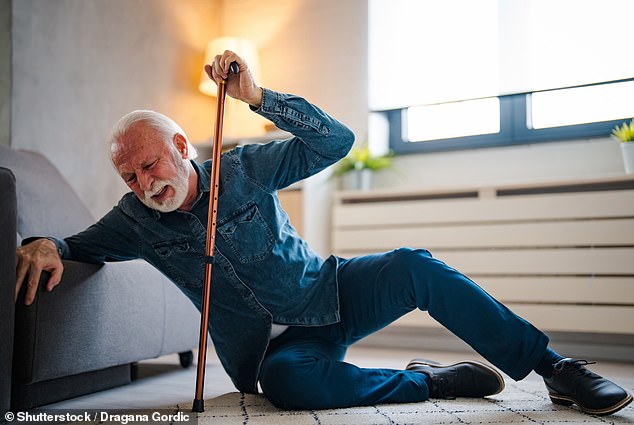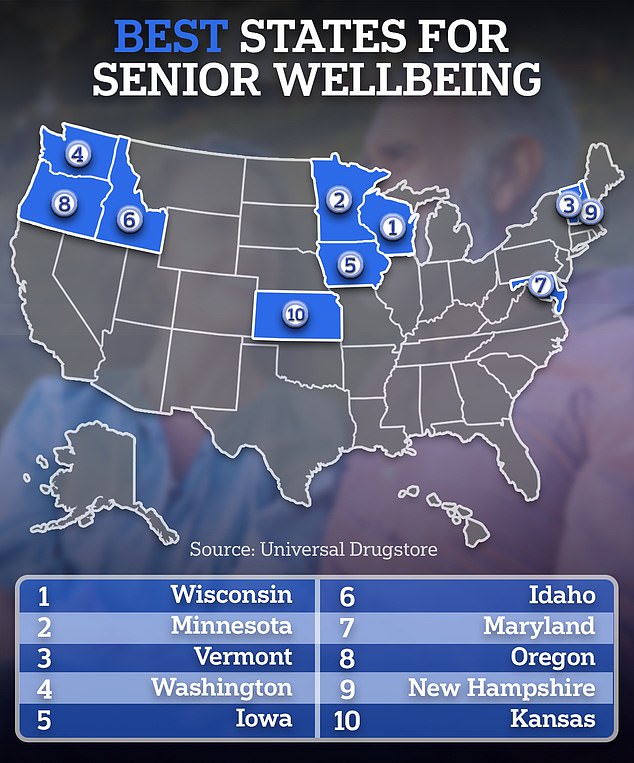Hundreds of thousands of seniors flock to sunny Florida or Southern California each year, but a new report has revealed America’s hidden gem states for retirement.
The Midwest and Western U.S. dominated the list of best areas for senior health and well-being, with Wisconsin taking the top spot, followed by Minnesota.
Both achieved wellbeing scores of more than eight out of 10, which consider access to healthcare, risk of social isolation, aged care facilities per capita, poverty rate and social support.
Florida and California don’t even make the top 10.
The ranking measured key factors such as access and quality of healthcare, social support for seniors, quality of life, healthy life expectancy and poverty rates to identify the best retirement havens. They were combined into a single score.
Meanwhile, southern states, led by Oklahoma, Mississippi and Alabama, made up most of the worst states for seniors to retire.
The United States did not rank well at Universal Drugstore Senior Wellness Reportwhich ranked the best places to retire around the world.
The report’s authors state: “While aging can present many challenges, they do not have to stop us from enjoying our old age.”
‘Aging is a natural part of life, so why not make the most of it and enjoy your golden years to the fullest?’
The United States ranked 26th out of 38 countries with a senior well-being score of 3.78.
The well-being score was calculated by combining data from several factors that impact the well-being of older people.
These factors were collected from various sources and weighted equally to form a composite score.
For countries, the score considered access and quality of health care, social support for people aged 50 and over, quality of life and healthy life expectancy at age 60.
For U.S. states, the score included risk of social isolation, access to health care, available senior living facilities per 100,000 people, and poverty levels among seniors. All of these factors were weighted equally to rank locations based on senior well-being.
Wisconsin ranked first, with a well-being score of 8.62, thanks to its low poverty rate, abundant senior living facilities and relatively low risk of social isolation.
Minnesota followed in second place with a score of 8.21, performing well on most factors, including a low poverty rate and reasonable access to senior living facilities.
Vermont came in third with a score of 8.11, standing out for its access to health care and balanced performance across all factors.
Washington State ranked fourth, with a well-being score of 8.06, followed by Iowa with a score of 8.01 and Idaho with a score of 7.81.
After Idaho came Maryland, with a score of 7.4, Oregon with 7.14, New Hampshire with 7.09 and Kansas with 7.04.

Seniors need social support to thrive. The states with the lowest scores for risk of social isolation were New Hampshire, Idaho and Minnesota.
Easy access to healthcare services is paramount for seniors, who are more susceptible to serious viral and bacterial infections, broken bones, and falls.
People’s senior years may also include time in a nursing home or other type of long-term care facility.
Oregon had the most senior facilities per capita, about 29 per 100,000, followed by Wisconsin, with about 22 per 100,000.
Social support is also crucial to avoiding what can become debilitating loneliness and keeping an older person’s mind active.
Social isolation risk measures the likelihood that older adults will experience a lack of social connections, including interactions with family, friends, and community members.
The risk was lowest in New Hampshire and Idaho, respectively, at 24th and 26th, followed by Minnesota, at 35th, and Wisconsin, at 37th.

The lowest-ranked states shared high rates of poverty among seniors, poor access to health care, a high risk of social isolation, and a lack of senior facilities. These factors contributed to a lower overall quality of life for older adults.
On the other end of the spectrum was Oklahoma, with the lowest well-being score: 0.87.
The risk of social isolation was 77 and the per capita number of nursing homes was 4.14. The poverty rate among seniors was also high, at 15.4 percent.
The average poverty rate was about 6.5 percent on average across the 10 states.
After Oklahoma came to Mississippi, it ranked second lowest in well-being at 0.97, had a poverty rate of 14.9 percent, fewer than six retirement communities per capita, a social isolation risk of 100, and It ranked second to last in the country in access to health care. .
Then came Alabama, with a well-being score of 1.5, a poverty rate of nearly 14 percent, 4.3 nursing homes per capita, an isolation risk score of 83 and the 38th worst access score to health care.
Louisiana was fourth worst at 1.79, followed by New Mexico at 1.84 and Arkansas at 2.04. West Virginia was tied with Arkansas.
Texas ranked eighth with a score of 2.19, followed by Kentucky with 2.60 and New York with a score of 2.81.
The United States’ life expectancy rate was lower than that of top-performing countries, including Switzerland, Iceland and Norway.

Seniors are prone to infections and falls, making access to healthcare services paramount. The states that scored the highest in this regard were Vermont, New Hampshire, Maryland and Iowa.
While Americans, on average, can expect to live to be around 76 years old, life expectancy in several European countries exceeds 19 years after turning 60.
The American population approaching retirement is growing as the majority of the population ages. At the same time, fewer babies have been born than ever in the United States. There were 55 births per 1,000 women of reproductive age in 2023, CDC data shows, fewer than any other year on record.
Birth rates plummeted after the Great Recession of 2008 and never fully recovered.
In addition to considering the financial cost of having a child, millions of women choose to prioritize their careers and personal growth before having a baby. For this reason, births are being transferred to older mothers, with the birth rate being highest among women aged 30 to 34.
Retirement can also be expensive. More than half of Americans who work full-time, part-time or are temporarily unemployed worry about their ability to fund their retirement. Nearly half of workers with specific retirement goals, such as traveling, don’t believe they have the money to do so in the future.
Many older Americans cannot retire at the traditional age of 65.
In the past, pensions and Social Security provided financial security for retirees, allowing them to retire with dignity. But today, only 10 percent of Americans Retirees between ages 62 and 70 are financially stable, according to research by labor economist Teresa Ghilarducci of The New School for Social Research.
Most older Americans retire with a lower standard of living than they had while working or cannot afford to retire.


